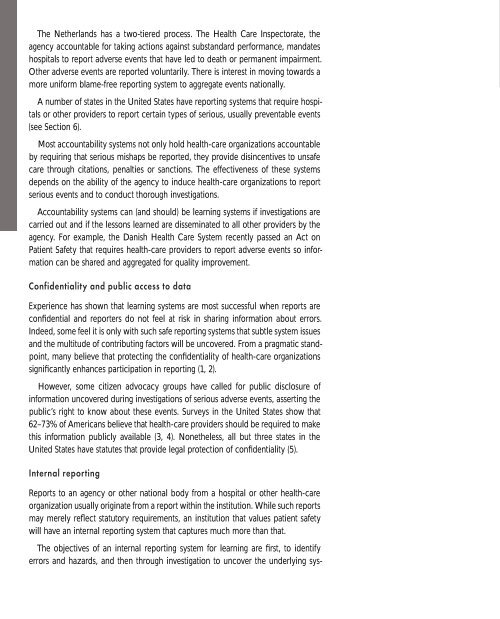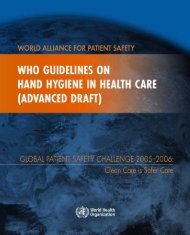Adverse event reporting.pdf
Adverse event reporting.pdf
Adverse event reporting.pdf
You also want an ePaper? Increase the reach of your titles
YUMPU automatically turns print PDFs into web optimized ePapers that Google loves.
The Netherlands has a two-tiered process. The Health Care Inspectorate, the<br />
agency accountable for taking actions against substandard performance, mandates<br />
hospitals to report adverse <strong>event</strong>s that have led to death or permanent impairment.<br />
Other adverse <strong>event</strong>s are reported voluntarily. There is interest in moving towards a<br />
more uniform blame-free <strong>reporting</strong> system to aggregate <strong>event</strong>s nationally.<br />
A number of states in the United States have <strong>reporting</strong> systems that require hospitals<br />
or other providers to report certain types of serious, usually pr<strong>event</strong>able <strong>event</strong>s<br />
(see Section 6).<br />
Most accountability systems not only hold health-care organizations accountable<br />
by requiring that serious mishaps be reported, they provide disincentives to unsafe<br />
care through citations, penalties or sanctions. The effectiveness of these systems<br />
depends on the ability of the agency to induce health-care organizations to report<br />
serious <strong>event</strong>s and to conduct thorough investigations.<br />
Accountability systems can (and should) be learning systems if investigations are<br />
carried out and if the lessons learned are disseminated to all other providers by the<br />
agency. For example, the Danish Health Care System recently passed an Act on<br />
Patient Safety that requires health-care providers to report adverse <strong>event</strong>s so information<br />
can be shared and aggregated for quality improvement.<br />
Confidentiality and public access to data<br />
Experience has shown that learning systems are most successful when reports are<br />
confidential and reporters do not feel at risk in sharing information about errors.<br />
Indeed, some feel it is only with such safe <strong>reporting</strong> systems that subtle system issues<br />
and the multitude of contributing factors will be uncovered. From a pragmatic standpoint,<br />
many believe that protecting the confidentiality of health-care organizations<br />
significantly enhances participation in <strong>reporting</strong> (1, 2).<br />
However, some citizen advocacy groups have called for public disclosure of<br />
information uncovered during investigations of serious adverse <strong>event</strong>s, asserting the<br />
public’s right to know about these <strong>event</strong>s. Surveys in the United States show that<br />
62–73% of Americans believe that health-care providers should be required to make<br />
this information publicly available (3, 4). Nonetheless, all but three states in the<br />
United States have statutes that provide legal protection of confidentiality (5).<br />
Internal <strong>reporting</strong><br />
Reports to an agency or other national body from a hospital or other health-care<br />
organization usually originate from a report within the institution. While such reports<br />
may merely reflect statutory requirements, an institution that values patient safety<br />
will have an internal <strong>reporting</strong> system that captures much more than that.<br />
The objectives of an internal <strong>reporting</strong> system for learning are first, to identify<br />
errors and hazards, and then through investigation to uncover the underlying sys-
















